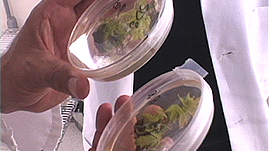Teachers' Domain - Digital Media for the Classroom and Professional Development
User: Preview

Source: SPARK:"One Trees"



When people think of science projects, many people conjure images of laboratories, test tubes and researchers in white lab coats. However, in this video segment from SPARK , the line between science and art is blurred when a long-term art project involving genetically identical trees, doubles as a controlled experiment.
One of the major characteristics separating human beings from the animal kingdom is our ability to solve complex problems. As long as humans have existed we have sought to explore our surrounding environment and find answers to the interesting questions that it presents
All science is founded upon the need to answer questions about the world around us. Why is the sky blue? Why are leaves green? Why does the sun set? These questions may seem simple enough to answer now, but that’s only because at some point in the past someone asked a questions about our environment and sought the answers to them.
The scientific method is the process that scientists use to investigate different phenomena, such as the question of the color of the sky. The scientific method is also used as a way to better understand and sometimes correct more established theories. The scientific method is founded on the ability to make observations based on available data, or evidence, that can be measured. After making observations and gathering information, scientists make a prediction. That prediction is called a hypothesis and it forms the basis for experimentation. A hypothesis, like an educated guess, can be right or wrong
Experiments are used to test a hypothesis and determine its accuracy. There are many different factors that can affect the accuracy of an experiment. These factors, called variables, are the elements of the experiment that can change, such as weight, color or speed.
 Loading Standards
Loading Standards